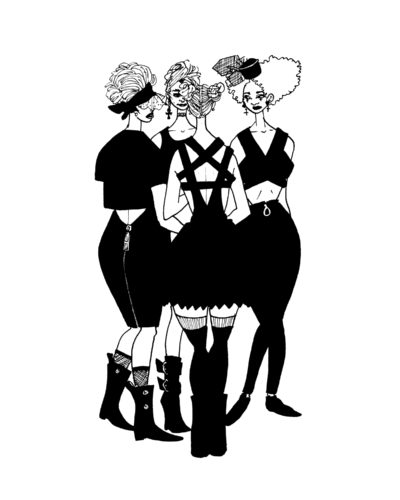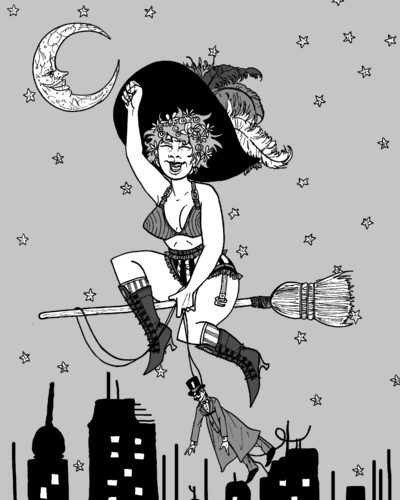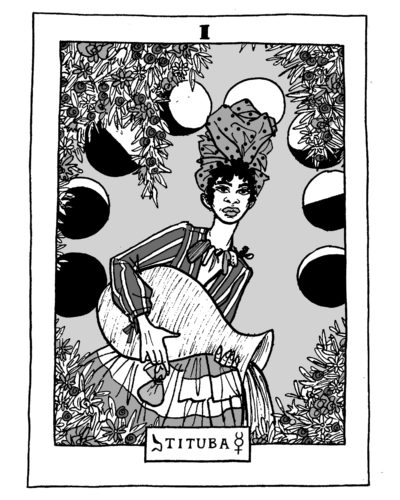Conjuring the Sex Positive: WITCHES, SLUTS, FEMINISTS by Kristen J. Sollee, with illustrations by Coz Conover, is a pristine work of critical theory spruced up with enough stylish words to keep the modern woman thirsty with curiosity and flushed with diabolical pride. Kristen Sollee, professor of Gender Studies at The New School and founding editrix of Slutist, the award-winning sex positive feminist website, distills her subject into shiny nuggets. Whether you are a balls out modern Wiccan or just rock the Witch, Please beanie; maybe you just prefer to quietly practice nude gardening, holistic vegan midwifery, Black girl magic or Tumblr your “Riot not Diet”; when Sollee’s words wax poetic, you’ll throw them back with gusto. Her text will slither down into your gut, adorn you tenderly like pearls of wisdom strung on the throat of a queen crone.
Between the sheath of its sleek black and yellow jacket, Sollee’s slim book gives us the skinny on why “slut” and “witch” make “bittersweet bedfellows.” What she calls evocative and nebulous “darketypes,” slut is in many ways the witch of the twenty-first century. Her book details how centuries of male fear of female sexual power drove the patriarchy’s rise to power. Women were not only historically scapegoated for Western society’s ills, they were and are punished, disempowered, policed and victimized. The author leaves no stone unturned, with bids for the Cosmic Mother, including a more expansive and inclusive take on the archetypal trinity maiden/mother/crone; ecofeminist discourse and how the collective aspects of witchcraft triggered societal hysteria. She even interrogates American hypercapitalism’s vogue for witch merch, questioning if “tapping into the spiritual industrial complex to sell spooky swag” might be causing more problems for third world women and the earth than we like to admit. Meanwhile punk, BDSM, goth and gory sexual lore about the dildos of domesticity marinate betwixt words of power from America’s notorious raptresses, riptides from the tidal wave that is Black Twitter and political sorcery that could seer the state.
Before misogyny became medicalized, WITCHES, SLUTS, FEMINISTS informs, the Bible wrote out the Goddess and her sacred whores. Her milk and honey was eclipsed by a social order that strove to erase and suppress her ferocious power at all costs. “Prevailing archetypes of womanhood in the Bible become virgin, obedient wife or deviant whore” writes Sollee, and her book shines a light on “the abyss of fear, sexist violence, and toxic masculinity” that necessarily still dominates feminist discourse to this day. “The witch-as-wicked-woman trope may have gotten its start in the church, but the state ran with it, and witchcraft morphed from heresy to treason — a crime against the community itself,” goes the story.
With an estimated 200,000 people accused of witchcraft and fifty thousand executed between the late fifteenth and eighteenth centuries (near eighty percent of whom were women), the anti-feminism shaping modern European society was enough to almost stomp out the magical, liberated, free-wheeling sheroes of the day. Not only are the facts of this much sensationalized genocide still muddled, but what is buried beneath that in the age of techno-capitalism and big pharma is the way in which women’s age-old power as nature-based healers was usurped to establish the primacy of “real” (male) medical knowledge and the male-dominated medico-religious system. Doing away with the wise women, marginalizing the midwives and corporatizing the goodies of Gaia would seed the nightmare of our modern medical-industrial complex. The medicalization of birth, normalization of pharmaceuticals, and new enforced designations of health/illness that monetize through life-long dependence on chemical quick-fixes and medical stimulants would never scratch the surface of the real root of our mad/bad/sad society.
Meanwhile, the witch hunts still continue today throughout the world, and it is estimated that the number of witch executions in modern times is about 200 a year. In many cases, the violence is directly sponsored by state or local government. The book details witchy women exiled into “witch camps” in Ghana, murdered in Northeast India and Tanzania, stripped and burned alive in Papua New Guinea. Sollee is able to briefly sketch the monstrous tenor of global violence against women without oversighting the pervasive misogyny and unnerving 1st-world luxury problem hypocrisy shading our conversations in the U.S.A. “We created a public spectacle out of murder during the witch trials, and the United States continues to create a murderous spectacle hanging African Americans during the Jim Crow era and beyond, to our current media display spreading viral videos of police brutality today. What art and also earth-based religions can do is to refuse the social control suggested by spectacle-based acts of violence perpetrated by our leaders and in our communities. We have agency through art and ritual to create our own contracts that in turn lead others out of the darkness.” Sollee urges artists and new age spiritual practitioners to be the first to “ignite” this change.
Modern violence against women meanwhile dovetails with rape culture, sustaining long-term the normalized physical and emotional terrorism enacted against the others of white male capitalist patriarchy. Again and again, weaving her words with glittering precision, Sollee breaks it down for the modern woman (insert witch, bitch, slut, beast, hag), being careful, of course, to not only highlight the “invisible links between the witch, femininity, and womanhood,” but to do so from a necessarily inclusive, twenty-first century intersectional feminist standpoint. In the spirit of Kimberle Crenshaw, who coined third and fourth-wave feminism’s central theory — intersectionality — this books speaks to the matrix of oppression that disproportionately effects women of color. The dialogue is inclusive of trans women and anyone on the spectrum. “From diabolical sorceress to symbol of feminist empowerment — and back,” WITCHES, SLUTS, FEMINISTS includes Interviews with many a modern day Bruja, including folks like Bri Luna, founder of The Hoodwitch and Rebecca Goyette, the visual artist best known for her breakout solo show of 2016 “Ghost Bitch U.S.A.” Sollee writes critically about Goyette’s show in NYC, illustrating how the artist drew parallels between the persecution of witches and contemporary misogyny, alchemizing ancestral trauma and repressed memories of sexual assault as a young girl.
Historical figures that factor into Sollee’s modern witch hall-of-fame include Sojournor Truth, for her syncretic spiritual practice amalgamating West African animistic beliefs, American folk magic, Dutch Calvinism and Methodism; Yin Q. a writer, BDSM educator, and self-identified “shamanatrix;” rapper Azealia Banks who announced her witch identity to the world on Twitter; digital artists Molly Soda (the “Virtual Spellbook”) and Tarin Tower (emoji spells); and Atlanta-based “stripper with a PhD” Lux ATL (Stripcraft Spellbook). Let’s not forget Yoko Ono, who, in 1974 at the moment she was Rock’s most reviled woman, released “Yes, I’m a Witch,” singing… “Yes, I’m a Witch, I’m a Bitch, I don’t care what you say.” Nor Annie “fearless sex slut” Sprinkle who’s generative early performance art bridged the gap between alternative spirituality and sex.
A few paragraphs are dedicated to Lemonade, Beyonce’s smash-hit 2016 visual album “lauded for elevating black femininity, and criticized for promoting consumer capitalism,” “packed with symbology alluding to Yoruban religion, Ifa, Santeria, Candomble and Voodoo.” Hailed the “‘epitome of black girl magic,’ practicing witches were the first to spot the water flowing beneath Beyonce’s golden dress as a reference to Oshun, the Yoruban goddess of water, femininity, and sensuality from an Afro-Latinx spiritual tradition that spans continents and cultures,” writes Sollee.
Meanwhile, “Hags for Hillary” and “Witches for Hillary” rallied unsuccessfully last year to appoint “the first witch in the White House,” while mainstream editorials flood the media “positioning Clinton as a shrewd sorceress.” Over the years, the imagery and lore associated with the witch has evolved, somewhat. Some of us might prefer the lurid early renaissance depictions Sollee details including witches “grinding lasciviously on phallic staffs, cavorting nude with horned beasts, and whispering unholy incantations into the blackened sky.” The thing with female independence — which is often collided with female sexual independence — is that it is still most frightening, even for us women. Why? Because “it liberates us from oppressive structures and having to rely on a patriarchal system to grant us power.” As complex and detailed as the author’s approach to the subject is, her words ring with ample clarity and wisdom, enough to lead you out of the maelstrom of sickening cultural dysphoria into a devout relationship with your bossBitch higher self.
With as many faces as the moon, including Inanna of Sumeria, Isis of Egypt and Kali of India, for Sollee, the witch embodies “the horror of the aging woman: the hag” and the “monstrous feminine,” the latter of which also encompasses male anxieties around the female body and lesbian sexuality linked to impotence and castration. If patriarchy created a whole fucked-up society based on its primal fear of women’s sexual power, it also created a disturbing mountain of art teasing out the pleasure-mixed-with-fear in its own spiritually vacant, psycho-sexual quagmire. “Unquenchable desire for the female sex mixed with fear, straddling horror and pleasure, disgust and arousal” is how the cultural producers within the male power structure approached the witch, writes Sollee. This is another brilliant aspect of the book, where Sollee is able to foil male-dominated depictions of witches in art with detailed descriptions of the work of several female artists who have, over the years, “tapped into generations of pain and power.” This collection tells the real story of the magical woman, seekers, mystics, scholars, shamanesses and visionaries who have pushed for a vision of the witch that could finally “transcend the well-worn binary of nubile temptress or vile hag.”
Because whether you combat sexism in ten-inch heels (or joggers, or flats, or shea butter-slathered bare feet to Gaia…), you should read this book and get a dose of the whole, scary truth. Maybe you throw it back with a spoonful of organic coconut sugar, tap your heels twice and start up your own thing. Maybe you’re already feeling too heavily shackled by contemporary society’s problems on problems on problems and you’d rather be gargling motor oil. Either way, the truth can set you free. Give it a whirl, or better yet, start a craft coven and upcycle your copy into a bewitched, bothered and bedazzled bible for the new world order.
Conjuring the Sex Positive: WITCHES, SLUTS, FEMINISTS by Kristen J. Sollee was published in 2017 with ThreeL Media
Follow illustrator Coz Con on Instagram @cozcon
Checkout Slutist “Tarting up the Body Politic in Shameless Fashions” online




